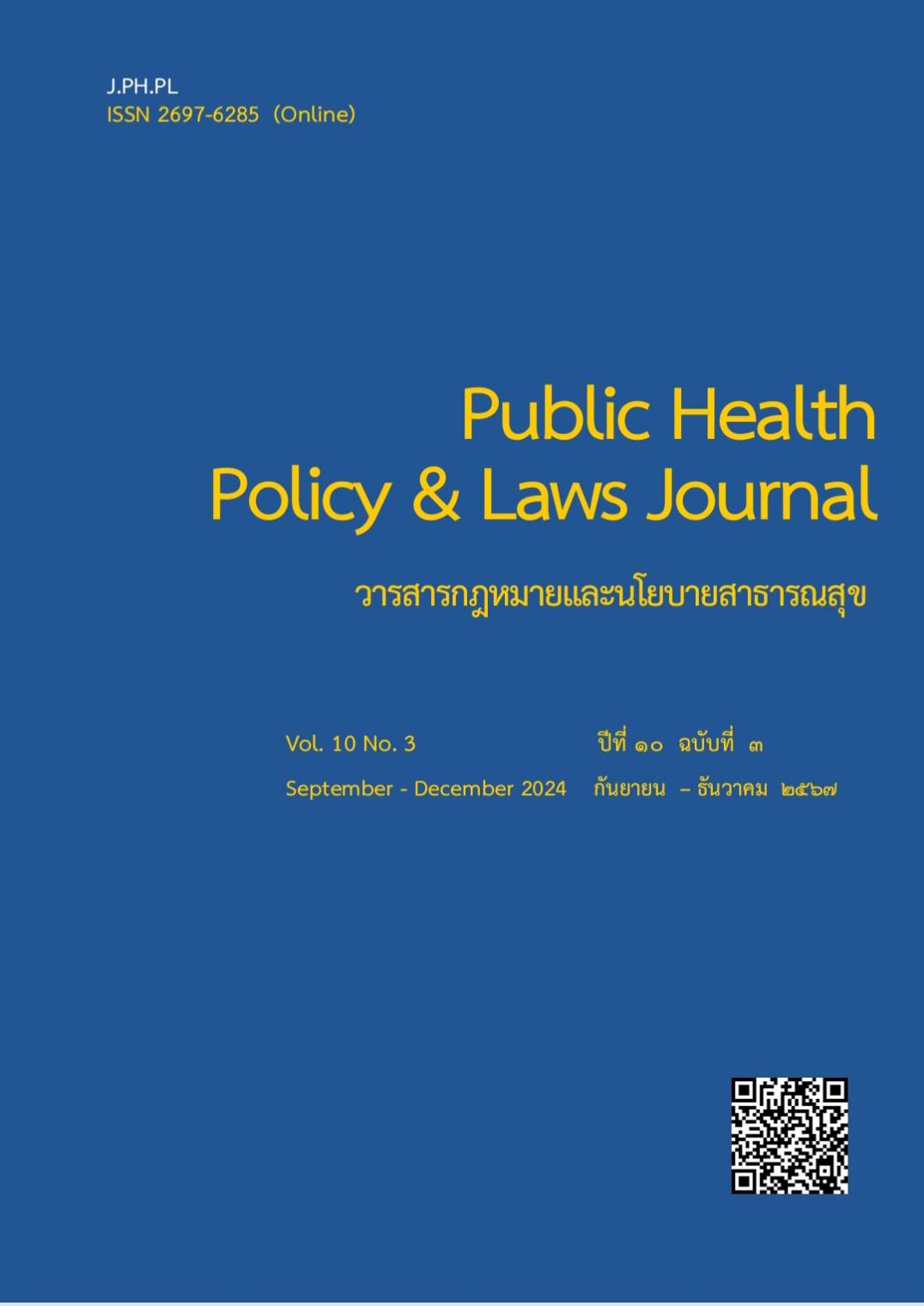Organization Atmosphere and Intention to Stay among Personnel of Thai Traditional and Alternative Medicine Department, Ministry of Public Health
Keywords:
intention to stay, organization climate, ministry of public healthAbstract
This cross-sectional analytical study aims to investigate the correlation among organizational atmosphere, and intention to stay among personnel of the Department of Thai Traditional and Alternative Medicine (DTAM). Sample size consisted of 197 personnel (89.95% responded rate) who had been employed for at least six months, not holding executive positions, or will retire in fiscal year 2023. Data were collected by using a self-administered questionnaires distributed between March 8th and April 8th, 2023. Data were analyzed by using descriptive statistics and Spearman's Rank correlation coefficient to identify factors associated with the intention to stay, at a significance level of 0.05.
The findings revealed that the staff's intention to stay was at a low level (Mean = 2.8, S.D. = 1.2). The factors that significantly correlated with the intention to stay included organizational atmosphere (r = 0.32), age (r = 0.31), marital status (r = 0.14), duration of work (r = 0.18), and income (r = 0.21)
The use of research result is for the administration of human resource management The information should be used to formulate policies and plans to retain personnel in the organization, focusing on developing a good organizational atmosphere.
References
Apaipakdi, K. (2020). Happy environment in workplace: Happy workers and achieving goals. Journal of
MCU Humanities Review. 6(1): 315-331.
Buncharoen, M. (2021). Human resource management report, year 2021 of the Department of Thai
Traditional and Alternative Medicine.
Chen, M.F., Ho, C.H., Lin, C.F., Chung, M.H., Chao, W.C., Chou, H.L. & Li, C.K. (2016).
Organisation-based self-esteem mediates the effects of social support and job satisfaction on intention to stay in nurses. J Nurs Manag. 24(1), 88-96.
Chupan, S., Khumyu, A., Vatanasin,S., & Vatanasin, D. (2017). Factors influencing intention to stay in
career among professional nurses. The Journal of Faculty of Nursing Burapha University.
(4): 1-10.
Drucker, P.F. (1979). The effective executive. New York: Harper and Row.
Hill, K.S. (2011). Work satisfaction, intent to stay, desires of nurses, and financial
knowledge among bedside and advanced practice nurses. The Journal of Nursing Administration. 41(6): 211-217.
Hinshaw, A.S. & Atwood, J.R. (1983). Nursing staff turnover, stress, and satisfaction:
models, measures, and management. Annu Rev Nurs Res. 1: 133-153.
Human Resources Group Office of the Secretary of the Department. (2022). Information on
personnel types, recruitment, transfer/resignation of the Department of Thai Traditional and Alternative Medicine, year 2019-2022.
Krejcie, R.V. & Morgan, D.W. (1970). “Determining Sample Size for Research Activities”.
Educational and Psychological Measurement. 30(3), 607-610.
Lan, Y., Huang, W., Kao, C. & Wang, H. (2020). The relationship between organizational climate,
job stress, workplace burnout, and retention of pharmacists. Journal of Occupational Health. 62(6): 1-9.
Milinthapunya, W. (2018). Factors related to retention of employees at a university of hospital.
Journal of Thonburi University Academic. 12(28), 243-255.
Ministry of Public Health. (2020). Annual government operational plan. Budget 2021 of the Ministry of Public Health. Nonthaburi: Ministry of Public Health.
Moosa, F., Chontawan, R., Akkadechanunt, T. (2016). Factors related to intent to stay among nurses in the
tertiary hospital, Maldives. Nursing JournaL. 43(2): 129-142.
Mowday, R.T., Porter, L.W. & Steers, R.W. (1982). Employee - organizational linkage: The
psychology of commitment absenteeism and turnover. New York: Academic Press.
Muneerat, S., Suwannapong, N., Tipayamongkholgul, M., Manmee, C. (2019). Job Characteristics,
Job-Related Stress and Intention to Stay in Professional Nurses in a Tertiary Care Hospital.
Journal of Health Science. 28(1): 133-141.
Nunnally, JC. (1978). Psychometrics theory 2nd ed. New York: NY: McGraw-Hill.
Peña-Suárez, E., Muñiz, J., Campillo-Álvarez, A., Fonseca-Pedrero, E. & García-Cueto, E.
(2013). Assessing organizational climate: psychometric properties of the CLIOR Scale. Psicothema. 25(1): 137-144.
Phumwiset, P. (2014). Public health system. and public health planning. Nonthaburi:
Charansanitwong printing limited.
Phaengkrathok, W., Klunduang, S. (2020). The work retention of back office personnel in Khonkaen
hospital. Journal of Khon Kaen Provincial Health Office. 2(2): 231-45.
Punthai, K. (2011). Integrated human resource development strategy: key for excellence. Nida
development journal. 51(3): 239-257.
Steering Committee for the Preparation of the National Health Development Plan No. 12
(2017-2021), Ministry of Public Health. (2016). Nonthaburi: Ministry of Public Health.
Strategy and Planning Group, Academic and Planning Division. (2020). Department of medical
services operational plan. Thai Traditional and Alternative Medicine, 3-year period
(2020-2022).
Taylor R. (1990). Interpretation of the correlation coefficient: a basic review. Journal of diagnostic medical
sonography. 6(5): 35-3
Thongniran, N., Intaraprasong, B., Pattara-Archachai, J. (2015). Intention to stay in
occupation of registered nurse at a community hospital region 1: central region, Thailand.
Journal of the Nursing Division. 42(3): 69-83.
Unjit, K., Intaraprasong, B., Sillabutra, J., Sattayasomboon, Y. (2018). Intention to stay in an
organization among core function staff in the department of thai traditional and alternative medicine, Ministry of Public Health. Journal of Public Health, 48(3): 308-318.
Wongwichai, C. (2015). Health workforce as a workforce: Problems and solutions of the Thai health system: Hfocus takes an in-depth look at the health system. [Internet]. Available from: https://www.hfocus.org /content/2016/04/12004
Downloads
Published
How to Cite
Issue
Section
License
Disclaimer and Copyright Notice
The content and information presented in articles published in the Journal of Law and Public Health Policy represent the opinions and sole responsibility of the respective authors. The editorial board does not necessarily agree with or assume any responsibility for the views expressed.
All articles, data, content, images, and other materials published in the Journal of Law and Public Health Policy are the intellectual property of the journal. Any individual or organization wishing to reproduce, distribute, or otherwise use the entirety or any part of such materials must provide proper citation.





